
Editor’s note: A version of this article first appeared in The American Spectator.
For Christians, Holy Week truly is the most holy week of the year. Or at least it should be. The only period of comparable significance is Christmas, which the secular culture celebrates as one day but is really a season of 12 days. Holy Week is actually the consummation of what began with the birth of Christ—a birth only and ultimately fulfilled through Christ’s crucifixion and resurrection. The life of Jesus Christ starts with Christmas but finds eternal birth (and hope) in the resurrection.
As Fulton Sheen put it in his The Life of Christ, Jesus Christ was the only person whose birth and death were preannounced. He was the one person brought into the world to die. It’s in the Garden of Gethsemane, the dark pivot point between the hosannas of Palm Sunday and the sorrows of Good Friday, that Christ in agony accepts that difficult fate—that is, the will of the Father: “Thy will be done.”
Holy Week every year retakes Christians through the path of that agonizing journey, the Via Crucis. The daily readings in the Lectionary re-witness the moments of Christ’s Way of the Cross. The readings are profound, whether the prophetic Old Testament selections from Isaiah and the Psalms to the extended Passion narratives of the New Testament covered on Palm Sunday and Good Friday. In these, the faithful observe their Redeemer consistently subjected to great injustices (all the greater given who He truly is): by the Sanhedrin, by the high priest, by Pontius Pilate, by false witnesses, by Judas’ betrayal and even by Peter denying him three times. The son of God even feels abandoned by his Father: “My God, my God, why have you forsaken me?”
There’s no greater love than to give one’s life for one’s friends. But imagine giving one’s life for one’s enemies. More so, imagine history’s only perfect One giving His life for all imperfect ones.
And so, it starts with Palm Sunday, as Christ enters Jerusalem to cheers of “Blessed is he who comes in the name of the Lord!” Within mere days, the crowd turns completely, mocking him, spitting on him, pleading instead to exchange a murderer for Christ (“Give us Barabbas!”), shouting “crucify him!” as he is scourged and fitted with a crown of thorns. Just days earlier, they hailed him as a hero, begging him to heal them, watching in awe as he did miracles, welcoming him into their homes.
All of this precedes the epic moment of the expiration of Christ, the long-awaited “One” who John the Baptist foretold as “the Lamb of God” who takes away the sins of the world. Jesus died at the very hour when the Passover lambs were being slaughtered in the Temple. The son of God was the purest and most undefiled Lamb, sacrificed to death without a bone broken, pouring out of his side blood and water as the Roman soldier pierced him.
By Good Friday, as darkness comes over the whole land, the erstwhile hero expires in an ignominious death on a cross between two thieves.
Each year, these readings never cease to stir the soul. My kids will attest to their embarrassment as I shake my head in the pew and express out loud (probably too loud) my astonishment at the grave injustices that Christ went through in the hours leading to him being nailed and lanced. “This is the son of God,” I’ll say, “look at how human beings treated him!” I tell my kids: “If humans would do this to the son of God, do not expect to be treated any better.”
Think of the long line of awful things human beings have done to one another since the day Christ was nailed to the cross—from feeding Christians to lions to the horrors of the Holocaust to the killing fields of Cambodia to the collapse of the Twin Towers, to every rape, lynching, Gulag, Pitesti, Camp 22, Auschwitz, to the countless abused children, to the scourge of abortion, etc., etc. We could go on and on with man’s inhumanity to man. But again, if they’d do it to the son of God, don’t expect any better.
The entire Passion experience recounted every year is a morality tale that speaks to us at so many levels. It gives meaning to Christ’s suffering and to our suffering. As for that meaning, Jesus Christ had a tough message for his followers for the ages to come: To follow Him, they must pick up the cross daily. They, too, cannot avoid suffering in this world. The Christian life is a cross; it is a sacrifice. No week better reminds us than Holy Week.
And alas, though the week is filled with sorrow, we must above all remember how it ends. Even as we share in Christ’s agony, including that cold Saturday when he was placed in the tomb, the week ends with hope. It’s a hope harder to find in our secular culture today, where sin seems to have so saturated everything.
And yet, as G. K. Chesterton said, hope is about having hope when things seem hopeless. The hope of the Resurrection, the culmination of Holy Week, is what this week is all about.

